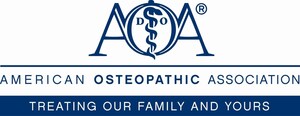CHICAGO, May 16, 2016 /PRNewswire-USNewswire/ -- Olympians and everyday athletes are optimizing their performance by integrating osteopathic physicians (DOs) into their training teams. No longer viewed as responsible only for injury, osteopathic sports medicine specialists, with their emphasis on the whole-person approach, are supporting athletes at every stage of the competition.
"The notion that physicians only treat pain and illness is archaic," said Naresh Rao, DO, team physician to the U.S. Olympic Mens' Water Polo team and author of Step Up Your Game. "Athletes now rely on an integrated network of healthcare practitioners working together to manage their physical, mental and emotional well-being throughout the training lifecycle – from pre-hab to post-competition recovery."
For elite athletes, the stakes are rarely higher than the Olympics. Osteopathic physicians take a lifecycle approach to competitions and athletes' careers, helping them maximize their playing years and achieve optimum performance throughout key benchmark phases. They consider the needs of the mind, body and spirit, while using a specific technique known as periodization, which aims to reach the best possible performance during the most important competitions of the year through a progressive cycle of training.
This practice is equally relevant for everyday athletes, according to Becca Rodriguez, DO, medical director of the high performance center for Team USA at the 2016 Olympics in Rio. "By reviewing the strengths, weaknesses and opportunities within the context of a training schedule, osteopathic sports physicians help athletes recognize their body's capabilities and hone in on the aspects with the greatest potential for improvement."
Core components of the osteopathic lifecycle approach to training include:
- Pre-hab and nutritional alignment – DOs help athletes manage their nutritional needs throughout training, changing up the mix of fats, carbs and proteins to match the intensity of the training. In this pre-hab phase, osteopathic physicians also hone in on strengthening athletes' weak zones to prevent overuse injuries. Supplements are generally discouraged, though some recommend nutraceuticals.
- Recovery – Rest and recovery are often an overlooked part of training success. With advanced knowledge in the body's structural makeup, DOs help elite athletes understand how proper stretching and alignment during off-hours can improve athletic performance. They also perform osteopathic manipulative treatment, a way of moving muscles and joints to relax the body and treat sports-related injuries.
- Mind fitness — Elite athletes understand that their mental state influences physical performance. Dr. Rao encourages competitors to keep in balance by focusing on being a role model to family, fans and friends — considering how they inspire others to perform and how their personal mentors push them to achieve. That external view is a powerful motivator in tough situations.
- Post-competition blues – Depression is a common after-effect for athletes because their identities become entwined with their sport and success, and its impact is not limited to elite athletes. Non-professional marathoners and triathletes are particularly susceptible because of dramatic changes in lifestyle, time management and purpose.
Regardless of whether the goal is a personal record or Olympic gold, athletes can partner with an osteopathic physician to understand their body's vulnerabilities. Preventing an injury is more valuable to any competitor than helping them heal after the fact.
"In sports, injuries frequently derail dreams. By working with Dr. Rao, I've stayed in the competition and avoided the career-threatening injuries common to the sport," said Tony Azevedo, USA Olympic water polo team captain, four-time Olympian and Silver Medalist. "The right support team can help any athlete extend their competitive days and perform at their personal best."
About the American Osteopathic Association
The American Osteopathic Association (AOA) represents more than 123,000 osteopathic physicians (DOs) and osteopathic medical students; promotes public health; encourages scientific research; serves as the primary certifying body for DOs; is the accrediting agency for osteopathic medical schools; and has federal authority to accredit hospitals and other health care facilities. More information on DOs/osteopathic medicine can be found at www.osteopathic.org.
Logo - http://photos.prnewswire.com/prnh/20150716/237742LOGO
SOURCE American Osteopathic Association
Related Links
WANT YOUR COMPANY'S NEWS FEATURED ON PRNEWSWIRE.COM?
Newsrooms &
Influencers
Digital Media
Outlets
Journalists
Opted In





Share this article